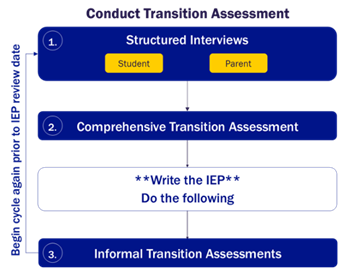What are transition assessments?
Transition assessments are a specific set of tools used to evaluate a student’s strengths, preferences, interests, and needs related to their goals for living, working, and learning after graduation from high school.
What is the purpose of transition assessments?
Transition assessments provide data that is used to:
- develop post-secondary goals
- identify the instruction, annual goals, activities, and services that allow the student to achieve their post-secondary goals
- describe the student’s strengths, preferences, interests and needs
- guide recommendations for instructional strategies and accommodations
- engage students in career development
- help students understand the connection between school and their post-school goals
Who conducts transition assessments?
Students may complete assessments independently, with assistance, or through observation by another individual. The IEP case manager will coordinate transition assessments, but many individuals may conduct assessments across environments that uniquely represent each student, such as:
- Special Education Teachers
- Vocational/Career and Technical Educator (CTE)
- General Education Teachers
- Transition Specialist/Coordinator (ESU or District representatives)
- School Counselor
- Parents/Guardian/Families
- Specialized Providers (Speech Language Pathologist, School Psychologist, Occupational Therapist, Physical Therapist, Teacher for Deaf/HOH, Teacher for Blind/Visually Impaired, etc.)
- Business partners through work-based learning opportunities
- Developmental Disability Provider
- Nebraska VR Counselor
- Mental Health Service Provider
- Juvenile Justice Staff
- Medical Professionals

The recommended steps for conducting transition assessments are as follows:
- Conduct student and parent structured transition interviews.
- Complete a comprehensive transition assessment.
For example, the ESTR or TPI. - Complete informal transition assessments. Summarize the results of the transition assessments. The transition assessment should identify the student’s specific needs, interests, questions. Transition assessments, use specific informal inventories, interviews, observations, and rating scales to obtain additional data. Informal transition assessments can also be used to document the data obtained from the completion fo the student’s transition activities in the current IEP.
- Begin this cycle again prior to the IEP review date.
It is best practice to analyze data obtained from transition assessments along with all available student information, such as attendance, classroom performance, and district-wide assessment data to develop a quality, transition-focused IEP.

IDEA
§§1414(VIII) beginning not later than the first IEP to be in effect when the child is 16 and updated annually thereafter- (aa) appropriate measurable postsecondary goals based upon age-appropriate transition assessments related to training, education, employment, and, where appropriate, independent living skills.
92 Nebraska Administrative Code 51 (Rule 51)
007.07A9 Beginning no later than the first IEP to be in effect when the child turns 16, or younger if deemed appropriate by the IEP team, and updated annually thereafter:
007.07A9a Appropriate measurable postsecondary goals based upon age-appropriate transition assessments related to training, education, employment, and, where appropriate, independent living skills.
Indicator 13
• Is there evidence that the measurable postsecondary goal(s) were based on age- appropriate transition assessment?
• Is (are) the postsecondary goal(s) updated annually?
